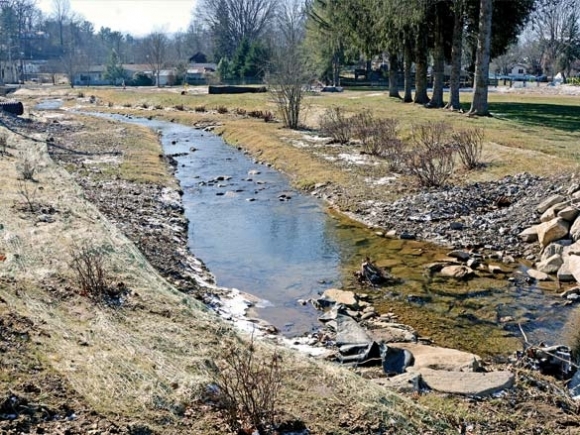Watery restoration: Waynesville and partners restore stream flows, aquatic habitat

Waynesville is in the midst of a makeover on three of its streams, and it’s a renovation that fish, crayfish and tadpoles alike are likely to find satisfactory.
One of the three projects is already complete, a rehabilitation of Shelton Branch at the Waynesville Recreation Park that wrapped up in October, with stream restorations at East Street Park and Chestnut Park poised to start soon.
The Shelton Branch project had been in process since summer 2016, when Waynesville Streets and Sanitation Superintendent Daryl Hannah approached the Haywood Waterways Association about helping the town get a permit to relocate the stream.
Running in a deep, eroded channel right next to Vance Street, Shelton Branch — which pours into Richland Creek — was undercutting the road, causing pieces of it to break off and fall down the side. Dirt continually washed into the stream as well, diminishing habitat quality for the aquatic creatures living there.
“The old channel was pretty straight up against the road,” said Haywood Waterways Director Eric Romaniszyn. “It was steep and eroding on the right side of the bank.”

Related Items
But fixing the problem wouldn’t be easy. Before the first shovelful of dirt could be moved, the town had to obtain permits from the Army Corps of Engineers and the N.C. Division of Water Resources. An engineer had to design the relocation, taking into account surrounding land use and upstream areas so that the new channel would be stable enough to handle major storms.
All of that takes money.
In total, the relocation cost about $52,000. A $14,000 grant from the Pigeon River Fund of the Community Foundation of Western North Carolina paid for part of it, with various partners putting in about $2,000 and the remaining $36,000 coming from the town. However, very little of that $36,000 was cash money — most of it was in-kind donations of labor and equipment use.
“We view it as a win-win because we get that section of stream cleaned up and improved, but it also makes a nicer public space,” said Town Planner Elizabeth Teague.
The earth-moving part of the project involved adding some curves — called “meanders” — to the stream to break up the water’s velocity, reducing erosion when storm runoff causes the water to move faster. The channel is wider now, too, giving stormwater a place to go besides the road or the field adjacent to the stream.
“A lot of rock was involved,” Romaniszyn said. “When we get eroding streambanks, of course the big issue is the stream is running up against that streambank. That rock was designed to keep the main power of that flow in the center of the channel, away from the streambanks.”
To finish it up, a variety of native species were planted on the stream banks to anchor the soil and improve wildlife habitat.
“I think when the spring comes and all the plants come up, it will be really nice,” Romaniszyn said. “In a couple of years you might not notice any work was ever done.”
However, neither Haywood Waterways, the Town of Waynesville, nor the Southwestern N.C. Resource Conservation & Development Council — which has also been a partner on these stream restoration projects — is drawing much of a breath following completion of the Shelton Branch project, because two more significant stream restoration efforts are on the horizon.
“It takes a while to put these thoughts down on paper, to apply for grants, to get your permitting done, and it just happens that all of these came about and we’re going to be working on them within this two-year timeframe,” Teague said. “It’s not new project ideas. It’s just that they’re finally coming to fruition.”
The RC&D recently landed a $206,000 grant from the Clean Water Management Trust Fund to complete two more stream restoration projects in Waynesville over the coming year.
Up next is a stream restoration at Chestnut Park, a 3-acre parcel of which the town gained ownership in September 2015. Upon securing the title, the town received a small grant to fix up some of the park furnishings and landed a $24,500 grant from the Pigeon River Fund to complete engineering work on the stream restoration. Design work is complete, and the project is shovel-ready once the weather gets warmer.
“The streambank had gotten so steep and incised that dirt was falling into the water, and the streambank itself was not safe,” Teague said. “It could collapse.”
Unlike Shelton Branch, this stream won’t require a full-on relocation. It’s on a steeper slope than Shelton Branch, so that type of stream is naturally straighter. However, the project will involve sloping the stream banks back a little bit to hold more water, putting in structures to get the water following more slowly and revegetating the banks.
“It’s a chance for us to clean up the stream itself and to beautify some of the plants and landscape along there, and create a few little access points where kids could get into the creek and play,” Teague said. “That’s part of our goal.”
Finally, the town is planning a phase two rehabilitation of the stream at East Street Park, which is an unnamed tributary to Shelton Branch. Phase one occurred in 2015, using grant money the Pigeon River Fund awarded to Haywood Waterways to restore a heavily channelized section below Happy Hollow Road. Phase two will focus on the upper section of the stream.
“That’s a much harder one to do,” Romaniszyn said. “It’s a narrower area to move the stream. It’s a much deeper channel and longer, too.”
The section in question is about 600 feet, significantly longer than the recently completed Shelton Branch restoration, which clocked in at less than 450 feet.
The RC&D is managing this project, which is also funded through the Clean Water Management Trust Fund grant.
“We have an opportunity to get in and clean up the stream, get all the trash and stuff out but also look at stream morphology — the shape of the stream and the flow,” Teague said.
The project will entail adding rock vanes and riffles to aerate the water, improving its capacity to house all manner of aquatic creatures.
Teague said the partnership of the three agencies — Waynesville, Haywood Waterways and the RC&D — has been key to getting projects like these three stream restorations off the ground. Each agency has a different area of expertise, different community connections and different grant opportunities.
“We’re often each of us in our realm given grant opportunities that maybe the other one doesn’t get,” Teague said. “So by working together, we can leverage in funds and also share and match so that we’re making the dollar go the farthest it can to get these projects done, and that’s been really important here in Haywood County.”









